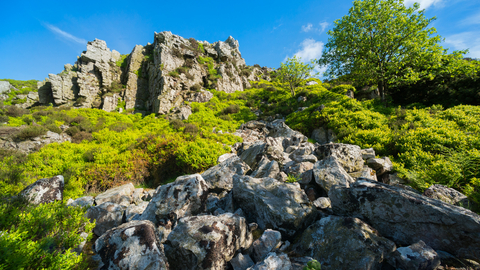
Shropshire and Beyond
Nipstone Rock
Location
Know before you go
Dogs
Dogs on leads between 1st March and 31st July due to ground nesting birds such as skylarks and pipits.
When to visit
Opening times
Open at all timesBest time to visit
All year roundAbout the reserve
The Stiperstones is one of Shropshire’s wildest places with craggy tors and rost-shattered quartzite boulders strewn on the ground. While a large part of the heathland ridge was designated a National Nature Reserve in the 1960s, areas outside its boundaries were engulfed by the fashion for conifers. Large blocks of spruce and fir were planted, blocking out views and destroying the places where red grouse, curlew, skylark, grayling butterflies and emperor moths once lived.
Some years ago Shropshire Wildlife Trust teamed up with English Nature (later Natural England), the Forestry Commission and others to restore heathland across the Stiperstones ridge through a project called Back to Purple. Today most of the conifers have gone and the purple flowers of heather along with juicy, dark whinberries have reappeared.
When the emperor moth caterpillar can creep from one end of the Stiperstones ridge to the other, the Back to Purple project will have achieved its original aim. The scheme has spurred on the felling of hundreds of acres of conifers planted in the 1960s and given heather and whinberry a chance to return. Conifer plantations were felled at Nipstone in 2001 and 2006 and the speed of recovery has been amazing. Already drifts of purple heather and bilberry are back, skylarks and meadow pipits nesting among the tussocks. An 11-acre swathe of oaks, rowan and ash has been planted, creating new foraging habitat for bats and birds.
Contact us
Location map
Become a member and support our work
The vital work we do for nature depends on the support of people who care about the future of Shropshire's wildlife and wild places.
